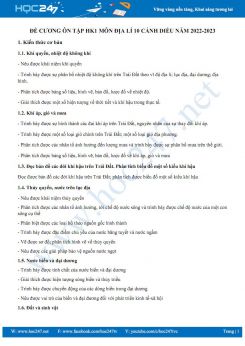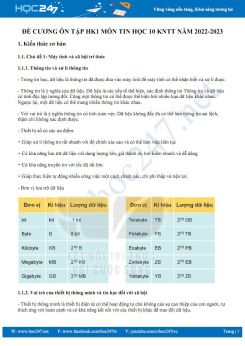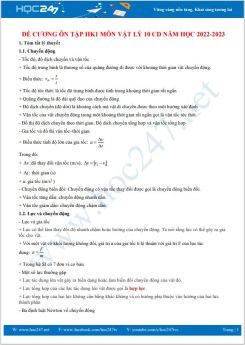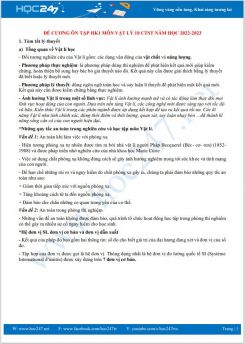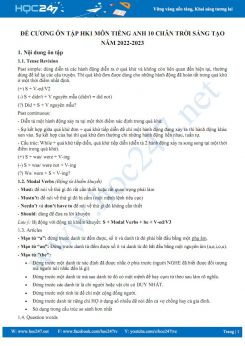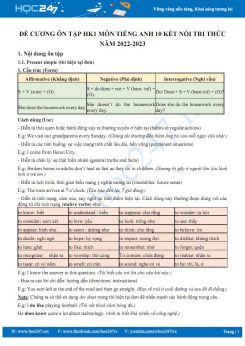Với những đổi mới trong nội dung Chương trình Tiếng Anh 10 Cánh diều phần nào đã làm cho các em gặp không ít trở ngại trong việc tìm kiếm tài liệu tham khảo, đặc biệt là trong kì thi Học kì 1 sắp đến. Hiểu được sự quan tâm từ phía bậc phụ huynh và các em học sinh, HOC247 xin giới thiệu nội dung Đề cương ôn tập giữa HK1 môn Tiếng Anh 10 Cánh diều năm 2022-2023. Hi vọng các em sẽ hệ thống toàn bộ kiến thức ngữ pháp và đánh giá bản thân thông qua những bài tập tự luyện ngay bên dưới nhé!
1. Nội dung ôn tập
1.1. Tense Revision
- Simple Past Tense (Thì Quá khứ đơn) như sau:
- Khẳng định:
- S + was/ were + ...
- S + V-ed/V2
- Phủ định:
- S + did not (didn't) + V nguyên mẫu
- S + wasn't / weren't + ...
- Nghi vấn:
- Did + S + V nguyên mẫu?
- Was / Were + S + ...?
Cách phát âm đuôi -ed
- Đuôi /ed/ được phát âm là /t/: Khi động từ kết thúc bằng âm /s/, /f/, /p/, /ʃ/, /tʃ/, /k/.
- Đuôi /ed/ được phát âm là /id/: Khi động từ kết thúc bằng âm /t/ hoặc /d/.
- Đuôi /ed/ được phát âm là /d/: Với những trường hợp còn lại.
Passive Voice in the Simple Past (Câu bị động trong thì Quá khứ đơn)
- S + was / were + V-ed/V3
- Was / Were + S + V-ed/V3?
- Simple Tense (Thì Hiện tại đơn)
Thì hiện tại đơn (Tiếng Anh: Simple present hoặc Present simple) là một thì diễn tả một hành động chung chung, tổng quát lặp đi lặp lại nhiều lần hoặc một sự thật hiển nhiên hoặc một hành động diễn ra trong thời gian hiện tại.
- Thể khẳng định
- Chủ ngữ số nhiều: S (I/ You/ We/ They) + V nguyên mẫu.
- Chủ ngữ số ít: S (He/ She/ It) + V-s/es
- Thể phủ định
- Chủ ngữ số nhiều: S (I/ You/ We/ They) + don't + V nguyên mẫu.
- Chủ ngữ số ít: S (He/ She/ It) + doesn't + V nguyên mẫu.
- Thể nghi vấn:
- Chủ ngữ số nhiều: Do + S (I/ You/ We/ They) + V nguyên mẫu?
- Chủ ngữ số ít: Does + S (I/ You/ We/ They) + V nguyên mẫu?
Cách sử dụng thì hiện tại đơn
- Diễn đạt một thói quen hoặc hành động lặp đi lặp lại trong hiện tại
- Chân lý, sự thật hiển nhiên
- Sự việc xảy ra trong tương lai. Cách này thường áp dụng để nói về thời gian biểu, chương trình hoặc kế hoạch đã được cố định theo thời gian biểu.
- Sử dụng trong câu điều kiện loại 1.
- Sử dụng trong một số cấu trúc khác
Dấu hiệu nhận biết thì hiện tại đơn
+ Always (luôn luôn) , usually (thường xuyên), often (thường xuyên), frequently (thường xuyên) , sometimes (thỉnh thoảng), seldom (hiếm khi), rarely (hiếm khi), hardly (hiếm khi) , never (không bao giờ), generally (nhìn chung), regularly (thường xuyên).
+ Every day, every week, every month, every year,……. (Mỗi ngày, mỗi tuần, mỗi tháng, mỗi năm)
+ Once/ twice/ three times/ four times….. a day/ week/ month/ year,……. (một lần / hai lần/ ba lần/ bốn lần ……..một ngày/ tuần/ tháng/ năm)
Present Continuous (Thì Hiện tại tiếp diễn)
- Khẳng định: S + am/ is/ are + Ving
- Phủ định: S + am/ is/ are + not + Ving
- Nghi vấn: Am/ Is/ Are + S + Ving?
Cách sử dụng thì hiện tại tiếp diễn
+ Diễn tả hành động đang diễn ra và kéo dài trong hiện tại.
+ Dùng để đề nghị, cảnh báo, mệnh lệnh.
+ Dùng để diễn tả một hành động sắp xảy ra trong tương lai theo kế hoạch đã định trước
+ Diễn tả sự không hài lòng hoặc phàn nàn về việc gì đó khi trong câu có “always”.
Thì hiện tại tiếp diễn trong câu thường có những cụm từ sau: At present, at the moment, now, right now, at, look, listen.…
1.2. Question words
- When? - Time ⇒ Hỏi thông tin về thời gian
- Where? - Place ⇒ Hỏi thông tin về nơi chốn
- Who? - Person ⇒ Hỏi thông tin về người
- Why? - Reason ⇒ Hỏi lý do
- How? - Manner ⇒ Hỏi cách thức, phương thức
- What? – Object / Idea / Action ⇒ Hỏi về vật / ý kiến / hành động
1.3. A, an, the, some và any
- A: Dùng trước danh từ số ít, đếm được bắt đầu bằng phụ âm.
- An: Dùng trước danh từ số ít, đếm được bắt đầu bằng nguyên âm (u, e, o, a, i)
- The: Sự vật, sự việc kể đến hai lần, chỉ các yếu tố duy nhất, đứng trước tính từ chỉ một nhóm người, trước từ chỉ tên riêng, chỉ quốc tịch, trước tên của tổ chức, nhiều bang, ...
- Some: được sử dụng cho các danh từ số nhiều đếm được. Đôi khi some cũng được dùng cho các danh từ không đếm được: some milk.
- Any: Trong câu hỏi và câu phủ định thì dùng "any" thay cho "some".
Tuy nhiên, khi chúng ta muốn đề nghị hay yêu cầu một cái gì đó thì sẽ dùng "some" thay thế cho "any".
1.4. Possession

1.5. To - infinitives. bare infinitives và gerunds
1.5.1. Infinitives with "to" (Động từ nguyên mẫu có “to”)
Động từ nguyên mẫu có “to” được dùng để:
- Làm chủ ngữ trong câu
E.g: To become a teacher is her dream. (Trở thành một giáo viên là giấc mơ của cô ấy)
- Làm tân ngữ của động từ
E.g: It's raining, so she decides to bring an umbrella. (Trời đang mưa, nên cô quyết định mang theo ô.)
- Làm tân ngữ của tính từ
E.g: I'm glad to see you here. (Tôi rất vui khi thấy bạn ở đây.)
- Chỉ mục đích:
E.g: Is there anything to eat? (Có gì để ăn ko?)
- Dùng sau các từ để hỏi "wh-": who, what, when, how... nhưng thường không dùng sau "why"
E.g: I don't know what to do. (Tôi không biết phải làm gì.)
- Đứng sau các từ 'the first': "the second': "the last, "the only".
E.g: Nam is the first person in my class to receive the scholarship. (Nam là người đầu tiên trong lớp tôi nhận được học bổng)
- Đứng trước các cấu trúc:
- It takes/took + O + thời gian + to + V-inf (Ai đó mất bao lâu để....)
- S + be + adj + to V-inf
- S + V + too +adj/adv + to + V-inf (quá...để...)
- S + V + adj/adv + enough + to + V-inf (đủ ....để...)
- I + think/ thought/ believe/ find + it + adj + to + V-inf (tôi nghĩ...để...)
- Dùng sau một số động từ. Ta có thể thêm "not" trước cụm "to +V-inf" để chỉ nghĩa phủ định: afford, agree, appear, arrange, attempt, begin, care, choose, consent, determine, happen, hesitate, hope, intend, pretend, propose, promise, refuse, love, offer, start, swear, ...
- Dùng sau một số động từ có tân ngữ đi kèm: ask, advise, allow, bear, cause, encourage, expect, forbid, force, get, hate, compel, intend, order, permit, like, invite, request, tell, trouble, want, prefer, warn, wish, teach...
Form: S + V + 0 + to + V-inf
- Dùng sau một số tính từ chỉ cảm xúc con người: able, unable, delighted, proud, ashamed, afraid, glad, anxious, surprised, pleased, easy, amused, annoyed, happy, ready...
1.5.2. Bare infinitives/ Infinitives without “to” (Động từ nguyên mẫu không có "to")
Chúng ta sử dụng động từ nguyên mẫu không có "to" khi:
- Đứng sau các động từ khuyết thiếu: can, could, should, may, might, will, shall, would, must...
- Đứng sau "had better","would rather/sooner" hay "rather than"
- Đứng sau "make': "let" Make/ Let + O + V (bare -inf)
- Đứng sau các động từ chỉ tri giác, thể hiện hành động đã hoàn tất hoặc biết được toàn bộ sự việc đã xảy ra: hear, smell, watch, notice, feel...
2. Bài tập ôn tập
Exercise 1: Choose the best answer among A, B, C, or D.
1. When I last saw him, he _____ in London.
A. has lived
B. is living
C. was living
D. has been living
2. We _______ Dorothy since last Saturday.
A. don’t see
B. haven’t seen
C. didn’t see
D. hadn’t seen
3. The train ______ half an hour ago.
A. has been leaving
B. left
C. has left
D. had left
4. Jack ______ the door.
A. has just painted
B. paint
C. will have painted
D. painting
5. My sister ________ for you since yesterday.
A. is looking
B. was looking
C. has been looking
D. looked
6. I ______ Texas State University now.
A. am attending
B. attend
C. was attending
D. attended
7. He has been selling motorbikes ________.
A. ten years ago
B. since ten years
C. for ten years ago
D. for ten years
8. Christopher Columbus _______ American more than 500 years ago.
A. discovered
B. has discovered
C. had discovered
D. had been discovering
9. He fell down when he ______ towards the church.
A. run
B. runs
C. was running
D. had run
10. We _______ there when our father died.
A. still lived
B. lived still
C. was still lived
D. was still living
11. They ______ table tennis when their father comes back home.
A. will play
B. will be playing
C. play
D. would play
12. By Christmas, I _______ for Mr. Smith for six years.
A. will have been working
B. will work
C. have been working
D. will be working
13. I _______ in the room right now
A. am being
B. was being
C. have been being
D. am
14. I ______ to New York three times this year.
A. have been
B. was
C. were
D. had been
15. I’ll come and see you before I _______ for the States.
A. leave
B. will leave
C. have left
D. shall leave
16. The little girl asked what _______ to her friend.
A. has happened
B. happened
C. had happened
D. would have been happened
17. John ______ a book when I saw him.
A. is reading
B. read
C. was reading
D. reading
18. He said he _______ return later.
A. will
B. would
C. can
D. would be
19. Jack ________ the door.
A. has just opened
B. open
C. have opened
D. opening
20. I have been waiting for you ______ .
A. since early morning
B. since 9 a.m
C. for two hours
D. All are correct
21. Almost everyone _______ for home by the time we arrived.
A. leave
B. left
C. leaves
D. had left
22. By the age of 25, he ______ two famous novels.
A. wrote
B. writes
C. has written
D. had written
23. When her husband was in the army, Mary ______ to him twice a week
A. was reading
B. wrote
C. was written
D. had written
24. I couldn’t cut the grass because the lawn mower ______ a few days previously.
A. broke down
B. has been broken
C. had broken down
D. breaks down
25. I have never played badminton before. This is the first time I _____ to play.
A. try
B. tried
C. have tried
D. am trying
26. Since _______, I have heard nothing from him.
A. he had left
B. he left
C. he has left
D. he was left
27. After I _______ lunch, I looked for my bag.
A. had
B. had had
C. have has
D. have had
28. By the end of next year, George _______ English for two years.
A. will have learned
B. will learn
C. has learned
D. would learn
29. The man got out of the car, ________ round to the back and opened the book.
A. walking
B. walked
C. walks
D. walk
30. Henry _______ into the restaurant when the writer was having dinner.
A. was going
B. went
C. has gone
D. did go
31. He will take the dog out for a walk as soon as he ______ dinner.
A. finish
B. finishes
C. will finish
D. finishing
32. I will be glad if he _______ with us.
A. had gone
B. did go
C. went
D. goes
33 Ask her to come and see me when she _______ her work.
A. finish
B. has finished
C. finished
D. finishing
34. Turn off the gas. Don’t you see that the kettle ________ ?
A. boil
B. boils
C. is boiling
D. boiled
35. Tom and Mary ______ for Vietnam tomorrow.
A. leave
B. are leaving
C. leaving
D. are left
36. He always ________ for a walk in the evening.
A. go
B. is going
C. goes
D. going
37. Her brother ______ in Canada at present.
A. working
B. works
C. is working
D. work
38. I ______ to the same barber since last year.
A. am going
B. have been going
C. go
D. had gone
39. Her father ______ when she was a small girl.
A. dies
B. died
C. has died
D. had died
40. Last week, my professor promised that he ________ today.
A. would come
B. will come
C. comes
D. coming
Exercise 2: Choose the word whose underlined part is pronounced differently from the others
|
1. A. arrived |
B. believed |
C. received |
D. hoped |
|
2. A. opened |
B. knocked |
C. played |
D. occurred |
|
3. A. rubbed |
B. tugged |
C. stopped |
D. filled |
|
4. A. dimmed |
B. travelled |
C. passed |
D. stirred |
|
5. A. tipped |
B. begged |
C. quarrelled |
D. carried |
|
6. A. tried |
B. obeyed |
C. cleaned |
D. asked |
|
7. A. packed |
B. added |
C. worked |
D. pronounced |
|
8. A. watched |
B. phoned |
C. referred |
D. followed |
|
9. A. agreed |
B. succeeded |
C. smiled |
D. loved |
|
10. A. laughed |
B. washed |
C. helped |
D. weighed |
Exercise 3: Give the correct forms (V-ing or to-V) of the verbs given.
1. A smartwatch can be used for ____________ (measure) your exercise efforts.
2. People use this electronic device _______ (connect) with other people all over the world.
3. This mobile application is used for recording and ________ (send) distress signals.
4. An e-book reader is convenient; it is used _______ (read) electronic books, newspapers or magazines.
5. Despite the convenience of motorbikes, many people ride their bicycle or walk _______ (keep) fit.
6. This machine is used for ______________ (massage) at home.
7. We can use a memory card ________ (store) a lot of music or photos.
8. This robot is designed for ________ (help) old people with certain household chores.
Exercise 4: Past Tense – Simple or Progressive: Fill in the correct form.
1. He suddenly (realize)___________ that he (travel)____________ in the wrong direction.
2. He (play)________________ guitar when someone (open)________________ the window and (throw)________________ out a bucket of water.
3. He (not allow)________________ us to go out in the boat yesterday because a strong wind
(blow)________________ .
4. The next day, as they (know)________________ that the police (look)________________ for them, they (hide)________________ the coats in the woods and (go_________________ off in different directions.
5. When I (come)________________ home they (sit)________________ around a fire. Jack (do)________________ a crossword puzzle, Judy (knit)________________ and the others (read)________________ . Mother (smile) ________________ at me and said : “ Come and sit down”.
Exercise 5: Choose the best answer to fill in the blank.
Several famous people are left-handed, (1) ____ Julius Caesar, Napoleon, and Albert Einstein. Queen Victoria of England was also left-handed, (2) ____ Prince Charles. Paul Mc Cartney of the Beatles plays (3) ____ guitar the opposite way from other guitarists because he is left-handed. Marilyn Monroe, the famous American star was also a leftie. Are you a leftie (4) ____ you write with your right hand? To understand (5) ____ it is necessary to look at the brain. The brain is (6) ____ into two hemispheres. The left hemisphere of the brain (7) ____ the right side of the body, and the right hemisphere controls the left side. Both of the sides of the body receive the same information (8) ____ the brain because the two hemispheres are connected. (9) ____, in the right handed people, the left hemisphere is stronger. In the left-handed people, it is the right hemisphere (10) ____ is stronger.
|
1. A. such as |
B. so as |
C. so that |
D. such that |
|
2. A. is so and |
B. and |
C. and so is |
D. and is so |
|
3. A. a |
B. an |
C. the |
D. no article |
|
4. A. as |
B. because |
C. even |
D. even though |
|
5. A. leftie |
B. lefthandedness |
C. left-handed |
D. lefthander |
|
6. A divided |
B. cut |
C. subtracted |
D. separated |
|
7. A. conquers |
B. controls |
C. contrasts |
D. consists |
|
8. A. on |
B. to |
C. from |
D. for |
|
9. A. In order that |
B. Therefore |
C. Never |
D. However |
|
10. A. who |
B. whom |
C. that |
D. where |
Exercise 6: Arrange these sentences of a review in the correct order.
A. He writes a letter to the company accepting the job and gives it to his son, Bobby, to post.
B. My award goes to young Justin Time, who plays Bobby.
C. Bob isn't too pleased, because he'd rather play football with his friends, but he sets off on the long walk to the post office.
D. Local playwright Hanna has given her hometown a chance to see her most successful play,
The Letter,
at the Lexford Playhouse.
E. The Letter is on for just one more week, so don't miss it.
F. The story is set in the 1930
G. Unaware of its importance, Bobby gives them the letter and runs off happily to play football.
H. The play is excellent, and the lighting, scenery, and sound effects are all very good. The cast perform it brilliantly.
I. If you want to know what happens next, you'll have to go and see the play for yourself, but believe me, you won't regret it.
J. John Barlow, who has been out of work for several months, is offered a job by a large engineering firm.
K. On the way he meets two older boys who offer to post the letter for him.
3. Đáp án
Exercise 1: Choose the best answer among A, B, C, or D.
|
1. C |
2. B |
3. B |
4. A |
5. C |
6. A |
7. D |
8. A |
9. C |
10. A |
|
11. B |
12. A |
13. D |
14. A |
15. A |
16. C |
17. C |
18. B |
19. A |
20. D |
|
21. D |
22. D |
23. B |
24. C |
25. C |
26. B |
27. B |
28. A |
29. B |
30. B |
|
31. B |
32. D |
33. B |
34. C |
35. B |
36. C |
37. C |
38. B |
39. B |
40. A |
Exercise 2: Choose the word whose underlined part is pronounced differently from the others
1 – D, 2 – B, 3 – C, 4 – C, 5 – A, 6 – D, 7 – B, 8 – A, 9 – B, 10 – D,
Exercise 3: Give the correct forms (V-ing or to-V) of the verbs given.
1. A smartwatch can be used for ______measuring_______ (measure) your exercise efforts.
2. People use this electronic device ____to connect_____ (connect) with other people all over the world.
3. This mobile application is used for recording and ____sending_____ (send) distress signals.
4. An e-book reader is convenient; it is used _____to read_____ (read) electronic books, newspapers or magazines.
5. Despite the convenience of motorbikes, many people ride their bicycle or walk _____to keep____ (keep) fit.
6. This machine is used for _______massaging________ (massage) at home.
7. We can use a memory card ____to store______ (store) a lot of music or photos.
8. This robot is designed for _____helping______ (help) old people with certain household chores.
Exercise 4: Past Tense – Simple or Progressive: Fill in the correct form.
1. He suddenly (realize)_____ realized______ that he (travel)______was travelling______ in the wrong direction.
2. He (play)________was playing________ guitar when someone (open)_______ opened_________ the window and (throw)__________threw______ out a bucket of water.
3. He (not allow)_________did not allow_______ us to go out in the boat yesterday because a strong wind (blow)______was blowing__________ .
4. The next day, as they (know)________knew________ that the police (look)________were looking________ for them, they (hide)________hid________ the coats in the woods and (go________went_________ off in different directions.
5. When I (come)________came________ home they (sit)________were sitting________ around a fire. Jack (do)_________was doing_______ a crossword puzzle, Judy (knit)_______was knitting_________ and the others (read)__________were reading______ . Mother (smile) ______smiled__________ at me and said : “ Come and sit down”.
Exercise 5: Choose the best answer to fill in the blank.
1A; 2C; 3C; 4D; 5B; 6A; 7B; 8C; 9D; 10C
Exercise 6: Arrange these sentences of a review in the correct order.
1. ___F___ 2. __J___ 3. ___A___ 4. ___C__ 5. ___K___
6. ___G___ 7. __I__ 8. ___H___ 9. ___B__ 10. ___E___
Trên đây là toàn bộ nội dung tài liệu Đề cương ôn tập HK1 môn Tiếng Anh 10 Cánh diều năm 2022-2023. Để xem thêm nhiều tài liệu tham khảo hữu ích khác các em chọn chức năng xem online hoặc đăng nhập vào trang hoc247.net để tải tài liệu về máy tính.
Mời các em tham khảo tài liệu có liên quan:
- Đề cương ôn tập HK1 môn Tiếng Anh 10 KNTT năm 2022-2023
- Đề cương ôn tập HK1 môn Tiếng Anh 10 CTST năm 2022-2023
Hy vọng tài liệu này sẽ giúp các em học sinh ôn tập tốt và đạt thành tích cao trong học tập.






